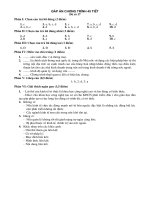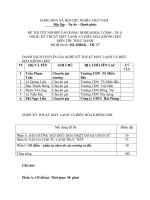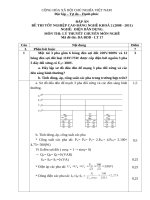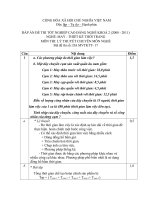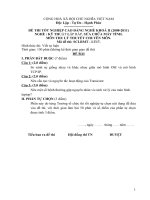17 zinc final
Bạn đang xem bản rút gọn của tài liệu. Xem và tải ngay bản đầy đủ của tài liệu tại đây (1.2 MB, 12 trang )
Myers
Chem 115
Organozinc Reagents: Asymmetric Additions to Carbonyl Compounds
Recent Reviews:
• In 1984, Oguni and Omi found that a small amount of (S)-leucinol catalyzed the enantioselective
addition (49% ee) of diethylzinc to benzaldehyde.
Pu, L.; Yu, H.-B. Chem. Rev. 2001, 101, 757–824.
Lemire, A.; Cote, A.; Janes, M. K.; Charette, A. B. Aldrichimica Acta 2009, 42, 71–83.
Lumbroso, A.; Cooke, M. L.; Breit, B. Angew. Chem. Int. Ed. 2013, 52, 1890–1932.
H3C
O
H
(C2H5)2Zn
+
2 mol %
Background:
OH
OH
CH3 NH2
CH3
toluene, 20 °C, 43 h
96% yield, 49% ee
• The reactivity of dialkylzinc reagents towards ketones and aldehydes is low; the rate of addition of
Et2Zn to benzaldehyde is negligible at room temperature.
Oguni, N.; Omi, T. Tetrahedron Lett. 1984, 25, 2823–2824.
• The addition of a catalytic amount of TMEDA will promote the addition of diethylzinc at room
temperature to 4-benzoylbenzaldehyde in 93% yield.
O
• In 1986, Noyori et al. published the first highly selective procedure for the asymmetric addition of
diethyl- and dimethylzinc to aldehydes employing (–)-3-exo-(dimethylamino)isoborneol (DAIB) as
a chiral catalyst.
OH
H
+
5 mol % TMEDA
(C2H5)2Zn
CH3
H3C
CH3
toluene, 23°C, 14 h
Bz
93%
N(CH3)3
OH
Bz
racemic
H3C
(–)-DAIB
Soai, K.; Watanabe, M.; Koyano, M. Bull. Chem. Soc. Jpn. 1989, 25, 2124–2125.
CH3
N
H3C Zn CH3
180 °
Zn—C
2 H3C
N
N
CH3
H3C
N
H3C
N CH
3
N
H3C
145 ° Zn CH3
N
H3C
N CH3
N
H3C
1.95 Å
Zn—C
+
R
OH
2 mol % (–)-DAIB
O
• X-Ray structures of dimethylzinc and its adduct with 1,3,5-trimethylhexahydro-1,3,5-triazine
show that upon bis-complexation, dimethylzinc shifts from a linear geometry to a tetrahedral
geometry and that the carbon-zinc bond length increases from 1.95 Å to 1.98 Å. This is
proposed to increase the nucleophilicity of the methyl groups, accelerating addition to
carbonyl compounds.
R'2Zn
toluene, 0 °C
H
R
R'
R
R'
% yield
% ee
Ph
Et
97
98
Ph
Me
59
91
p-ClC6H4
Et
86
93
p-CH3OC6H4
Et
96
93
(E)-PhC(H)=CH
Et
81
96
PhCH2CH2
Et
80
90
n-C6H13
Et
81
61
1.98 Å
Hursthouse, M. B.; Motewaili, M.; O'Brien, P.; Walsh, J. R.; Jones, A. C. J. Mater. Chem.
1991, 1, 139–140.
Kitamura, M.; Suga, S.; Kawai, K.; Noyori, R. J. Am. Chem. Soc. 1986, 108, 6071-6072.
Fan Liu, Michael Furrow
1
Myers
Chem 115
Organozinc Reagents: Asymmetric Additions to Carbonyl Compounds
Mechanism:
• The stoichiometry of aldehyde, diethylzinc, and DAIB ligand determines reactivity: alkylation occurs
only when the ratio of Et2Zn : DAIB is greater than 1:
• A non-linear dependence of product ee on catalyst ee was observed. Heterochiral dimerization to
form an unreactive species was invoked to account for in situ amplification of product ee:
OH
O
cat. (–)-DAIB
+
H
(C2H5)2Zn
8 mol % (–)-DAIB
O
CH3
H
toluene, 0 °C, 6 h
OH
15 % ee
CH3
(C2H5)2Zn
+
92% yield, 95% ee
aldehyde : Et2Zn : DAIB
% yield
% ee
1:1:0
1:1:1
50 : 50 : 1
0
1
97
—
0
98
H3C
CH3
N
H3C
Kitamura, M.; Okada, S.; Suga, S.; Noyori, R. J. Am. Chem. Soc. 1989, 111, 4028–4036.
O
H
H
CH3
Zn Et
CH3
(–)-DAIB
O
R Zn
+
H3C
CH3
N
H3C H C
3
CH3
(+)-DAIB
• This observation is consistent with a mechanistic proposal involving two Zn atoms per aldehyde:
H3C
CH3
H3C
N(CH3)3
OH
N
Et2Zn
H3C
H3C
H3C
H3C
CH3
O
H3C
CH3
H3C
Zn Et
O
Zn Et
H
O
Et Ar
H3C
H3C
CH3
Zn
Et
Et
H
H3C
CH3
CH3
N
O
H3C
Et
Zn
H3C
Zn
O
Et
CH3
slow
Et
CH3
CH3
H
N
H3C
Ar
Itsuno, S.; Fréchet, J. M. J. J. Org. Chem. 1987, 52, 4142–4143.
Corey, E. J.; Hannon, F. J. Tetrahedron Lett. 1987, 28, 5237–5240.
Evans, D. A. Science 1988, 240, 420–426.
O
Zn
H
O
CH3
O
H3C
H
H3C H C
3
H
CH3 O
Zn
Et Ar
Et
CH3
Zn R H3C
H3C
O
R Zn
CH3
CH3
N
H3C
H
CH3
+
heterochiral dimer, more
stable, does not readily
dissociate
H
CH3
N
O
H3C
Et
CH3
N
Zn R
Ar
CH3
CH3
N
CH3
N
CH3
O
H
R Zn
CH3
N
EtZnO
CH3 CH
3
CH3
Zn R
H
CH3 R Zn O
CH3
N
H3C
H3C H C
3
CH3
CH3
homochiral dimer, less
stable, dissociates
Kitamura, M.; Okada, S.; Suga, S.; Noyori, R. J. Am. Chem. Soc. 1989, 111, 4028-4036.
Oguni, N.; Matsuda, Y.; Kaneko, T. J. Am. Chem. Soc. 1988, 110, 7877.
Fan Liu, Michael Furrow
2
Myers
Chem 115
Organozinc Reagents: Asymmetric Additions to Carbonyl Compounds
• In many cases, lithium or magnesium halide byproducts must be removed to avoid salt complexation
with chiral additives in subsequent enantioselective processes.
Preparation of Organozinc Reagents:
Lemire, A.; Cote, A.; Janes, M. K.; Charette, A. B. Aldrichimica Acta 2009, 42, 71–83.
Knochel, P.; Perea, J. J. A.; Jones, P. Tetrahedron 1998, 54, 8275–8319.
• 1,4-Dioxane forms insoluble complexes with magnesium halides and allows the synthesis of
diorganozinc reagents that were not commercially available to subsequently be used in asymmetric
additions to carbonyl compounds:
• Metallic Zinc Insertion:
• One of the early methods involves treatment of an alkyliodide or bromide with zinc dust or an
activated form of Zn, such as zinc-copper couple (Zn(Cu)). The method requires rather harsh
conditions and is limited to low molecular weight dialkylzinc species due to the need to distill the
products while avoiding competitive Wurtz coupling:
ZnCl2
(1.0 M in Et2O)
1.
MgBr
(1.0 M in Et2O)
(salt free)
2. dioxane
Zn
3. filtration
O
+
EtI
[EtZnI]
Zn-Cu
EtBr
neat, reflux
Schlenk
Equilibrium
Et2Zn
+
+
[EtZnBr]
BrZnI
H
distillation
OH
O
N
OBn
CH3
• methanesulfonic acid can be used to activate zinc metal:
O
Br
Cl
EtO2C
ZnBr
THF, 70 ºC
von dem bussche-Hünnefeld, J. L.; Seebach, D. Tetrahedron 1992, 48, 5719–5730.
Brubaker, J. D.; Myers, A. G. Org. Lett. 2007, 9, 3523–3525.
F
NC
EtO2C
O
Cl
F
EtO2C
10.0 kg
Cl
2. 6N HCl
72%
11.5 kg
• Zn(OCH3)2 can also be used. The byproduct, CH3OMgCl, precipitates from the reaction mixture and
salt-free ethereal solutions of diorganozinc can be obtained after filtration or centrifugation:
Cl
10.6 kg
Et2O
CH3
2x
MgCl
H3C
+
CH3
Zn(OCH3)2
0 → 23 ºC
> 95%
Choi, B. S.; Chang, J. H.; Choi, H.-W.; Kim, Y. K.; Lee, K. K.; Lee, K. W.; Lee, J. H.; Heo, T.; Nam,
D. H.; Shin, H. Org. Process Res. Dev. 2005, 9, 311–313.
CH3
Zn
H3C
• Substrates that are less readily prepared by direct reduction can be prepared by treatment of a
Zinc(II) halide with two equivalents of alkyllithium or alkylmagnesium halide:
H
1. n-BuLi
THF, –60 ºC
O
N
Li
unstable
above –50 ºC
2 CH3OMgCl
• N,N,N,N-tetraethylethylenediamine (TEEDA) can be used to scavenge salts and the resulting in situ
formed zinc reagents function in catalytic asymmetric addition reactions to aldehydes:
3. O
H
O
+
CH3
Cote, A.; Charette, A. B. J. Am. Chem. Soc. 2008, 130, 2771–2773.
• Transmetallation with a Zinc Salt:
N
OBn
>80%
93% ee
N
89 %
1.
Zn
MsOH (5 mol%)
N
OLi
Et2Zn
200 ºC
<30 mmHg
O
THF, –75 ºC
ZnCl2
N
O
ZnCl
Pd(PPh3)4
(5 mol%)
60 ºC
Br
90%
stable
Br
N
O
MTBE
SO2CH3
SO2CH3
N
CH3
H3C
hexanes
H3C
CH3
N
OH
N
H3C
OH
1. n-BuLi 2. ZnCl2
H3C
O
(5 mol%)
CH3
TEEDA
Reeder, M. R.; Gleaves, H. E.; Hoover, S. A.; Imbordino, R. J.; Pangborn, J. J. Org. Process Res.
Dev. 2003, 7, 696–699.
Kim, J. G.; Walsh, P. J. Angew. Chem. Int. Ed. 2006, 45, 4175–4178.
TEEDA
(equiv) yield
ee
0
–
2
0.8
99
92
Fan Liu, Michael Furrow
3
Myers
• Transmetallation with a Diorganozinc Reagent:
• Functionalized diorganozinc reagents can be prepared via transmetallation of organolithium,
organoboron, organonickel, and organozirconium with dimethyl-, diethyl-, or diisopropylzinc:
• organolithium:
OZn–Et2Li+
OPiv
O
OPiv Me2PhSiLi,
ZnEt2;
H
Chem 115
Organozinc Reagents: Asymmetric Additions to Carbonyl Compounds
OBn MoOPH
OTBS
82%
Ph
Si
H3C
CH3
H
HO
Ph
Si
H3C
CH3
OBn
OTBS
H
• Halogen-Diorganozinc Exchange:
• Iodine-zinc exchange reactions have been used to prepare dialkylzinc species containing esters,
nitriles, chlorides, sulfonamides, and boronic acids. CuI or UV light were found to accelerate the
reaction. Removal of excess Et2Zn and EtI was necessary to drive the reaction:
Et2Zn, CuI (0.1 mol%)
neat, 50 °C;
O
AcOCH2(CH2)3CH2I
OPiv
(AcOCH2(CH2)3CH2)2Zn
0.1 mm Hg, 50 °C
> 95%
OBn
OTBS
Rozema, M. J.; Eisenberg, C.; Lütjens, H.; Ostwald, R.; Belyk, K.; Knochel, P. Tetrahedron Lett.
1993, 34, 3115–3118.
Rozema, M. J.; Sidduri, A.; Knochel, P. J. Org. Chem. 1992, 57, 1956–1958.
Substrate decomposition occurred in the absence of ZnEt2.
Milgram, B. C.; Liau, B. B.; Shair, M. D. Org. Lett. 2011, 13, 6436–6439.
n-Hex
• organoboron:
Et2Zn
CuI (3 mol%)
neat, 50 °C
O
CO2Et
1. Et2BH, Et2O, 0 °C
CO2Et
2. Et2Zn, neat, 0 °C
EtO2C
)2Zn
EtO2C
I
OEt
0.1 mm Hg
50 °C
OAc
O
O
O
O
n-Hex
t-Bu
EtO
)2Zn
OEt
O
TMSOTf, CH2Cl2
–78 ºC, 67%
O
t-Bu
> 86%
Powell, N. A.; Rychnovsky, S. D. J. Org. Chem. 1999, 64, 2026–2037.
Langer, F.; Schwink, L.; Devasagayaraj, A.; Chavant, P.-Y.; Knochel, P. J. Org. Chem. 1996, 61,
8229–8243.
• Aryl and alkenyl iodides can undergo halogen-zinc exchange with i-Pr2Zn. Li(acac)2 activates the
intermediate mixed diorganozinc as an ate complex and promotes the second exchange:
• organonickel:
OAc
)2Zn
Et2Zn (0.6 equiv), Ni(acac)2 (1 mol%)
OPiv
COD (2 mol%), neat, 50–60 °C
OPiv
> 40%
i-Pr2Zn
Li(acac)2 (10 mol%)
I
H3CO
2x
H
Et2O, NMP
25 ºC, 12 h
O
OAc
OTBDPS
CH2Cl2
0 → 23 ºC
ZnMe2
OTBDPS
toluene
–60 → 0 ºC
ZrCp2Cl
Wipf, P.; Xu, W. Org. Synth. 1997, 74, 205–211.
> 86%
i-Pr
Li(acac)2
O
OAc
I
H3CO
• organozirconium:
Cp2ZrHCl
Zn
H
>90%
Vettel, S.; Vaupel, A.; Knochel, P. J. Org. Chem. 1996, 61, 7473–7481.
OTBDPS
OAc
H3CO
OCH3
H
O
O
Zn
H3CO
i-Pr
H
Zn
AcO
OAc
Zn
H3CO
CH3
O
O
H
Li(acac)2
H
O
CH3
Li+
O
CH3
Kneisel, F. F.; Dochnahl, M.; Knochel, P. Angew. Chem. Int. Ed. 2004, 43, 1017–1021.
Fan Liu, Michael Furrow
4
Myers
Chem 115
Organozinc Reagents: Asymmetric Additions to Carbonyl Compounds
• 3-exo-morpholinoisoborneol (MIB), 4, more stable and easier to prepare than DAIB, catalyzes
Alkylzinc Addition to Aldehydes:
• A variety of chiral catalysts and ligands have been developed that promote the addition of dialkylzinc enantioselective additions to aldehydes with similar selectivity and efficiency. It also shows improved
selectivity with α-branched, aliphatic aldehydes:
reagents to give enantiomerically enriched secondary alcohols. Only a few representative ones are
shown here:
O
Et2Zn
O
OH
ent-4 (5 mol%)
H3C
H3C
H
Et
H3C
CH3
N
HO
O
hexanes, toluene
Ph
CH3
CH3
N
Ph
CH3
Ph
0 ºC, 94%
N
OH
99% ee
OH
H3C
N(n-Bu)2
CH3
HO
Nugent, W. A. Chem. Commun. 1999, 1369–1370.
1
2
3
4
H3C
H3C
Ph Ph Ph Ph
O O
O
O
Ti
O
O
O O
Ph Ph Ph Ph
N
CH3
CH3
OH
OH
NHTf
N
NHTf
5
6
7
• Ligand 1 extends the scope of the initial DAIB reaction to include aliphatic aldehydes:
Et2Zn
1 (6 mol%)
O
hexanes, 0 ºC
94%, 95% ee
H
Ph
• Using 5 as a chiral additive, either enantiomer of the product can be obtained by changing the
reaction conditions:
Et2Zn
5 (10 mol%)
Et2Zn
Ti(Oi-Pr)4
OH
O
5 (2 equiv)
(1.2 equiv)
Et
H
toluene
toluene
H3CO
0 → 23 ºC, 89% H3CO
–75 → 23 ºC, 86% H3CO
98% ee
94% ee
Schmidt, B.; Seebach, D. Angew. Chem. Int. Ed. 1991, 30, 99–101.
Et
Ph
• Chemoselective addition to aldehydes can be achieved in the presence of ketones:
Ph
H
O
O
Ph
toluene, 0 ºC
82%, 96% ee
n-Bu2Zn, Ti(Oi-Pr)4
6 (2 mol%)
O
Hayasaka, T.; Yokoyama, S.; Soai, K. J. Org. Chem. 1991, 56, 4264–4268.
Et2Zn
n-BuLi, 2 (8 mol%)
Et
H
toluene, –30 ºC
99%, 98% ee
OH
Ph
n-Bu
Yoshioka, M.; Kawakita, T.; Ohno, M. Tetrahedron Lett. 1989, 30, 1657–1660.
Takahashi, H.; Kawakita, T.; Yoshioka, M.; Kobayashi, S.; Ohno, M. Tetrahedron Lett. 1989, 30,
7095–7098.
• Unsymmetrical dialkyl zinc containing a trimethylsilylmethyl group as a non-transferable group can
be prepared to avoid losing one equivalent of valuable alkyl zinc precursor:
OH
(Cl(CH2)4)2Zn
+
(TMSCH2)2Zn
neat, 25 °C
(Cl(CH2)4)Zn(CH2TMS)
Watanabe, M.; Soai, K. J. Chem. Soc., Perkin Trans. 1, 1994, 3125–3128.
H3C
H3C
OH
Et2Zn
3 (5 mol%)
O
H
hexanes, toluene
0 ºC, 91%
99% ee
Nugent, W. A. Org. Lett. 2002, 4, 2133–2136.
Et
OH
Ph
O
OH
OH
H3C
H3C
Cl
6 (8 mol%)
Ti(Oi-Pr)4
Et2O, –20 °C
O
H
Et
86%, > 94% ee
Berger, S.; Langer, F.; Lutz, C.; Knochel, P.; Mobley, T. A.; Reddy, C. K. Angew. Chem., Int. Ed.
Engl. 1997, 36, 1496–1498.
Fan Liu, Michael Furrow
5
Myers
Chem 115
Organozinc Reagents: Asymmetric Additions to Carbonyl Compounds
Alkenylzinc Addition to Aldehydes:
Dialkylzinc Reagents in Synthesis:
• The first example of catalytic asymmetric vinylzinc additions to aldehydes was reported using a
chiral diaminoalcohol ligand:
H3C
CH3
(n-C5H11)2Zn
Ti(Oi-Pr)4
6 (20 mol%)
O
OCH3
H
H3CO
CH3
O
88% yield, >98% ee
n-Bu
H3C
O OH
O
(20 mol%)
OH
n-Bu
H
Zn
O
H
N(CH3)2
N
H3CO
toluene
–78 → –20 °C
OH
OH
OCH3
hexanes, 0 ºC
90%, 96% ee
O
Oppolzer, W.; Radinov, R. N. Tetrahedron Lett. 1988, 29, 5645–5648.
CH3
• Mixed organozinc reagents, formed via transmetallation of organoboron or organozirconium with
dialkylzinc, can be used to form enantiomerically enriched allylic alcohols in the presence of a chiral
amino alcohol catalyst:
(–)-Gloeosporone
Fürstner, A.; Langemann, K. J. Am. Chem. Soc. 1997, 119, 9130–9136.
O
H
2.
O
O
H
CH3
(Br(CH2)5)2Zn
Ti(Oi-Pr)4
6 (8 mol%)
O
H3C
OH
Et2Zn
(–)-DAIB (1 mol%)
O
H3C
60%, 82% de
CH3
69%, 92% ee
Oppolzer, W.; Radinov, R. N. Helv. Chim. Acta. 1992, 75, 170–173.
Oppolzer, W.; Radinov, R. N.; De Brabander, J. Tetrahedron Lett. 1995, 36, 2607–2610.
OH
(10 mol%)
Bu2Cu(CN)Li2
95%
O
Br
toluene
–60 → –20 °C
THF, –60 → 0 °C
HO
1. (Cy)2BH•S(CH3)2
hexanes
–20 → 23 °C
CH3 H3C
Ginnol
n-Bu
H
1. Cp2ZrHCl
CH2Cl2, 23 ºC
n-Bu
2. Me2Zn
toluene, –65 ºC
Zn
CH3
Langer, F.; Schwink, L.; Devasagayaraj, A.; Chavant, P.-Y.; Knochel, P. J. Org. Chem. 1996, 61,
8229–8243.
SH
CH3
N(CH3)2
OH
n-Bu
O
Cl
H
83%, 97% ee
Cl
toluene, –30 ºC
Wipf, P.; Ribe, S. J. Org. Chem. 1998, 63, 6454–6455.
Fan Liu, Michael Furrow
6
Myers
Chem 115
Organozinc Reagents: Asymmetric Additions to Carbonyl Compounds
• Hydride migration from a boron ate complex provides access to enantiomerically enriched Z-allylic
alcohols:
OTBDPS
Cl
1. (Cy)2BH
MTBE
H
Cy2B
• Direct transmetallations from vinyl iodides provide alkenylzinc reagents not accessible through
hydroboration or hydrozirconation:
H3C
2. t-BuLi
–78 → 23 °C
OTBDPS
Et2Zn
Li(acac)2
(26 mol%)
I
Cl
–20 → 23 °C
Li
n-Bu NMP, 0 ºC
H3CO
H
H
H3C
H3C
Cy B
Cy
O
7 (10 mol%)
CH3
H
HO
CH3
CH2Cl2
n-Bu
H3CO
O
H
CH3
O
OTBDPS
94%, >99% ee
Cl
DeBerardinis, A. M.; Turlington, M.; Pu, L. Angew. Chem. Int. Ed. 2011, 50, 2368–2370.
OH
4 (5 mol%)
–78 → 23 °C
OTBDPS
S
O
S
69%, 93% ee
Alkenylzinc Reagents in Synthesis:
Et2Zn
TEEDA
H
H
–78 °C
1. t-BuLi
Et2O, –78°C
2. ZnBr2,
Et2O, 0 ºC
OTBDPS
BCy2
H
I
TMS
CH3
Salvi, L.; Jeon, S.-J.; Fisher, E. L.; Carroll, P. J.; Walsh, P. J. J. Am. Chem. Soc. 2007, 129, 16119–
16125.
3. H3C
CH3
TBSO
H
OCH3
CH3 OH
TMS
TIPS
• Tri-substituted Z-allylic alcohol can also be prepared:
TBSO
NMe2
+
Ph
OLi
91% yield, 95% ee
(2.5 equiv)
toluene, 0°C
CH3
OCH3
O
H
1. (Cy)2BH
toluene
Br
Cy2B
n-Bu
n-Bu
TMEDA
4 (5 mol%)
toluene, 0 ºC
O
Cy
Cy
Cy B
Et
Br
0 → 23 °C
OH
n-Bu
2. Et2Zn
–78 → 0 °C
H
Cy
n-Bu
Et
Zn
Et2Zn
I
2. TBAF, THF
0 → 23 °C
HO
OCH3
OH
97% yield, 90% ee
H3C
O
Cy
Et
1. as above
TBSO
H
n-Bu
HO
+
Br
H
CH3
TIPS
n-Bu
B
OH
Cy
H
50%, 95% ee
O
H OHC
O
(–)-Longithorone A
Kerrigan, M. H.; Jeon, S.-J.; Chen, Y. K.; Salvi, L.; Carroll, P. J.; Walsh, P. J. J. Am. Chem. Soc.
2009, 131, 8434–8445.
CH3
CH3
Layton, M. E.; Morales, C. A.; Shair, M. D. J. Am. Chem. Soc. 2002, 124, 773–775.
Fan Liu, Michael Furrow
7
Myers
Chem 115
Organozinc Reagents: Asymmetric Additions to Carbonyl Compounds
Arylzinc Addition to Aldehydes:
Alkynylzinc Additions to Aldehydes
Schmidt, F.; Stemmler, R. T.; Rudolph, J.; Bolm, C. Chem. Soc. Rev. 2006, 35, 454–470.
Recent Reviews:
• Unlike dialkylzinc additions, diphenylzinc additions to aldehydes take place smoothly even without a
catalyst. This background reaction has made it more difficult to develop enantioselective variants.
• Ligand 7 (see page 5) has been found to promote highly enantioselective additions of diphenylzinc
and functionalized diaryl zinc to aromatic and aliphatic aldehydes:
O
I
OCH3
Et2Zn
Li(acac)2
(26 mol%)
7 (10 mol%)
NMP, 0 ºC
THF, 0 ºC
Wu, X.-F.; Neumann, H. Adv. Synth. Catal. 2012, 354, 3141–3160.
Trost, B. M.; Weiss, A. Adv. Synth. Catal. 2009, 351, 963–983.
Pu, L. Tetrahedron 2003, 59, 9873–9886.
• Mixed alkylalkynylzinc reagents can be prepared directly from terminal acetylenes and have been
shown to undergo catalyzed 1,2-additions to aldehydes with good enantioselectivities.
OH
H
O
23 ºC
OCH3
R1
DeBerardinis, A. M.; Turlington, M.; Ko, J.; Sole, L.; Pu, L. J. Org. Chem. 2010, 75, 2836–2850.
R2
H
10 mol % (S)-cat.
Et2Zn
THF, reflux
R1
ZnEt
OH
R2
THF
R1
• Widely available aryl boronic acids and boroxines can be directly transformed into arylzinc reagents
and undergo enantioselective arylation of aldehydes with excellent selectivity:
Et2Zn
Ph B(OH)2
Ph ZnEt
toluene
60 ºC, >95%
O
O
8 (10 mol%)
DiMPEG
(10 mol%)
N
OH
t-Bu
OH
Ph
8
Cl
O
p-ClC6H4
Bolm, C.; Rudolph, J. J. Am. Chem. Soc. 2002, 124, 14850–14851.
OTBS
N
O
B
B
O
Et2Zn
toluene
60 ºC
47.6 kg
OH N
toluene, –10 ºC
H
B
O
CH3
(S)-cat.
Fe Ph Ph
DiMPEG = dimethoxy
poly(ethyleneglycol)
OTBS
H3C CH
3
Ph
Ph
Ph
(20 mol%) OH
R2
T (°C)
% yield
% ee
C6H5
C6 H 5
0
64
90
C6H5
c-Hx
0
88
91
C6H5
t-Bu
0
61
95
Ph3Si
c-Hx
23
55
91
C6H13
t-Bu
23
67
87
C6H13
C6H5
23
41
78
CN
TBSO
O
H
OH
R1
CN
88%, >94% ee
• The low yields in these reactions was attributed in part to competitive addition of ethyl groups to the
aldehydes.
17.6 kg
OTBS
–5 → –10 ºC
Ishizaki, M.; Hoshino, O. Tetrahedron: Asymmetry 1994, 5, 1901.
Magnus, N. A.; Anzeveno, P. B.; Coffey, D. S.; Hay, D. A.; Laurila, M. E.; Schkeryantz, J. M.; Shaw,
B. W.; Staszak, M. A. Org. Process Res. Dev. 2007, 11, 560–567.
Fan Liu, Michael Furrow
8
Myers
Chem 115
Organozinc Reagents: Asymmetric Additions to Carbonyl Compounds
• In 2000, Carreira et al. published an in situ preparation of alkynylzinc reagents and their addition to
aldehydes with excellent enantioselectivities and yields.
• Enantioselective additions of 2-methyl-3-butyn-2-ol to aldehydes provide access to optically active
terminal acetylenes after cleavage of acetone from the products.
• The reactions can be carried out without rigorous exclusion of oxygen or moisture using reagentgrade toluene (84–1000 ppm H2O).
• Protection of the 2° propargylic alcohol prior to cleavage of acetone from the adducts leads to
improved yields.
• All reagents are stoichiometric or superstoichiometric.
OH
CH3
CH3
H
OH
O
R1
H
H
R2
H3C
R1
R
R2
(+)-N-methyl ephedrine
O
NMe2
Ph
Zn(OTf)2, Et3N
H
R2
R
(–)-N-methyl ephedrine
OH
(+)-N-methylephedrine
OBz
toluene, 110 ºC
R
H
toluene, 23 °C;
benzoyl chloride
yield (%)
cat. 18-cr-6
K2CO3
OH
H3C CH3
Zn(OTf)2, Et3N
toluene, 23 °C
R1
OBz
R
% overall yield
% ee
n-C3H7
68
99
n-C5H11
71
98
98
ee (%)
n-C5H11
CH2CH2Ph
94
97
n-C5H11
Ph
90
97
t-Bu
65
c-C6H11
73
99
TIPSO(CH2)2
71
97
i-Pr
Ph
96
92
Ph
Ph
82
93
Frantz, D. E.; Fassler, R.; Carreira, E. M. J. Am. Chem. Soc. 2000, 122, 1806–1807.
Frantz, D. E.; Fassler, R.; Tomooka, C. S.; Carreira, E. M. Acc. Chem. Res. 2000, 33, 373–381.
Boyall, D.; Frantz, D.; Carreira, E. M. Org. Lett. 2002, 4, 2605–2606.
For an investigation on the reaction mechanism, see: Fässler, R.; Tomooka, C. S.; Frantz, D. E.;
Carreira, E. M. Proc. Natl. Acad. Sci. 2004, 101, 5843–5845.
Boyall, D.; Lopez, F.;Sasaki, H.; Frantz, D.; Carreira, E. M. Org. Lett. 2000, 2, 4233–4236.
• The resulting terminal acetylene can be used to prepare enantiomerically enriched 1,4-diols:
• It was shown that by raising the reaction temperature to 60 °C, the in situ zinc acetylide formation
and addition reaction can be made catalytic in both zinc and chiral ligand.
• The system is less effective for aromatic aldehydes because of a competitive Cannizzaro reaction.
OBz
CH3
+
H
O
H3C
H
CH3
+ H
OTMS
CH3
CH3
(+)-N-methyl
ephedrine (22 mol%)
OH
Et3N, toluene, 60 °C
77%, 98% ee
Anand, N. K.; Carreira, E. M. J. Am. Chem. Soc. 2001, 123, 9687–9688.
CH3
O
OBz
CH3
Zn(OTf)2, Et3N
toluene, 60 °C
CH3
OH
72%, 99% ee, dr = 92 : 8
H3C
Zn(OTf)2 (20 mol%)
H
(–)-N-methyl ephedrine
CH3
OTMS
CH3
CH3
Diez, S. R.; Adger, B.; Carreira, E. M. Tetrahedron. 2002, 58, 8341–8344.
Fan Liu, Michael Furrow
9
Myers
Chem 115
Organozinc Reagents: Asymmetric Additions to Carbonyl Compounds
• A mannose-derived auxiliary was employed to promote diastereoselective alkynylzinc additions to
nitrones. The nitrone auxiliary was prepared from mannose, acetone and N-hydroxylamine.
• Hydroxylamines are readily reduced to free amines:
Ph
O
–O +
N
R1
H
H
H
O
O
R2
HO
O
CH3
Zn(OTf)2 (0.5 equiv)
Me2NCH2CH2OH (0.5 equiv)
O
CH3
Et3N, CH2Cl2, 23 °C;
H
N
N
Bn
H3C
Xc*
R1
Ph
Zn, AcOH, H2O
OH
H3C CH3
NHBn
H3C
81%
Pinet, S.; Pandya, S. U.; Chavant, P. Y.; Ayling, A.; Vallee, Y. Org. Lett. 2002, 4, 1463–1466.
R2
• The oxazepanedione shown below, prepared in 3 steps from ephedrine and dimethyl malonate,
undergoes condensation with aldehydes mediated by TiCl4. Conjugate addition of zinc alkynylides
followed by hydrolysis and decarboxylation give β-alkynyl acids in good yields and selectivities:
H3C CH3
H2NOH•HCl, NaOAc
HN
O
OH
H3C
N
H3C
+
R1
MeOH, H2O, 60 ºC
O
HOHN
R2
H
O
O
CH3
CH3
H
O
R1
R2
CH3
Ph
88
95:5
i-Pr
C(OH)Me2
98
96:4
overall yield (%)
Ph
O
O
R , TiCl4
H3C
H3C
N
pyridine, THF
–78 → 23 ºC
Ph
O
O
H
O
Ph
O
H
R
O
Zn(OTf)2 (60 mol%)
Et3N, CH2Cl2, 23 ºC
dr
t-Bu
Ph
91
97:3
Ph
SiMe3
88
95:5
Ph
Ph
R = i-Pr, 97%,
>98% ee
R = c-C6H11, 83%,
>98% ee
Fassler, R.; Frantz, D. E.; Oetiker, J.; Carreira, E. M. Angew. Chem., Int. Ed. Engl. 2002, 41,
3054–3056.
• The use of ZnCl2 homogenizes the reaction mixture and obviates the need for N,Ndimethylethanolamine:
1. KOH, PrOH, 97 ºC
H3C
H3C
N
Ph
O
O
O
HO
2. DMSO, 100 ºC
R
R
O
• Lowering the loading of Zn(OTf)2 to 20 mol% resulted in lower selectivites and isolated yields.
Knöpfel, T. F.; Boyall, D.; Carreira, E. M. Org. Lett. 2004, 6, 2281–2283.
• A highly effective two-catalyst system was reported for the addition of zinc acetylide to aromatic
aldehydes. The stereochemistry of BINOL determines the stereochemistry of the products, while the
second ligand improves catalytic activity and enantioselectivity:
H3C CH3
O
O
+
–O +
N
R1
H
H
O
O
CH3
O
CH3
H
H
ZnCl2, Et3N
toluene, 23 °C
92%, dr = 96 : 4
HO
N
O
Xc*
p-BrC6H4
R1
Topic, D.; Aschwanden, P.; Fässler, R.; Carreira, E. M. Org. Lett. 2005, 7, 5329–5330.
R2
H
H
OH
Ph
(S)-BINOL (10 mol%)
Ligand (10 mol%)
Zn(CH3)2, THF, 0 °C
85%, 99% ee
H3C
p-BrC6H4
NHTs
Ph
Ph
OH
Ligand
Li, X.; Lu, G.; Kwok, W. H.; Chan. A. S. C. J. Am. Chem. Soc. 2002, 124, 12636–12637.
Fan Liu, Michael Furrow
10
Myers
Chem 115
Organozinc Reagents: Asymmetric Additions to Carbonyl Compounds
Alkynylzinc Reagents in Synthesis:
H3C CH3
TBDPSO
Ph
H
+
O
O
CH3 O
CH3 OTBS
CO2CH3
10 steps
OH
O
H3C
HO
(CH3O)2HC
H3CO
O
O
HO
H3CO
CH3 CH3
OH
OH O
H3C
CH3 CH3 OCH3
BOMO
13 steps TBDPSO
CH3
(CH3O)2HC
CH3
O
O
AcO
O
OH
O
O
H3C
CH3
CH3 CH3 OH
Kleinbeck, F.; Carreira, E. M. Angew. Chem. Int. Ed. 2009, 48, 578–581.
O
Me
OTE
S
H3C
H3C CH3
C5H11
+
(+)-N-Me-ephedrine
H
O
H
CH3 CH3
H3CO2C
(–)-Bafilomycin A1
O
O
Zn(OTf)2, i-Pr2NEt
toluene, 23 ºC
91%, dr > 95 : 5
CH3
CH(OMe)2
TBAF, DMF, THF
–78 → 5 ºC, 99%
single diastereomer
(+)-N-Me-ephedrine
H3C
CH3 CH3 O
i-Pr
Ph
BOMO
OTES
Zn(OTf)2, Et3N
toluene, 23 ºC
90%, dr = 6 : 1
CH(OMe)2
CH3
CH3 CH3
H3CO2C
+
H
(–)-N-Me-ephedrine
O
O
H3CO
O
H3C
CH3 OTBS
CO2CH3
H
O
H
H
H3CO2C
Zn(OTf)2, i-Pr2NEt
toluene, 23 ºC
91%, dr > 95 : 5
CH3
O
Me
7 steps
CH3
O
CH3
(–)-Salvinorin A
C5H11
1. Red-Al, Et2O
3Å MS, 0 → 23 ºC
I
OH
CH3
CH3
C5H11
2. I2, –20 ºC, 99%
OH
CH3
CH3
C5H11
CH3
7 steps
Scheerer, J. R.; Lawrence, J. F.; Wang, G. C.; Evans, D. A. J. Am. Chem. Soc. 2007, 129, 8968–
8969.
O
H3C
O
CH3
OH HO
OH
CH3
(–)-Tulearin C
Lehr, K.; Mariz, R.; Leseurre, L.; Gabor, B. Fürstner, A. Angew. Chem. Int. Ed. 2011, 50, 11373–
11377.
Fan Liu, Michael Furrow
11
Myers
Chem 115
Organozinc Reagents: Asymmetric Additions to Carbonyl Compounds
Asymmetric Addition to Ketones:
• Ketones are less reactive than aldehydes and often give 1,2-addition products in lower yields
because of competitve enolization or reduction of the carbonyl group.
• Salen ligand 10 and Schiff base ligand 11 were found to promote efficient addition of zinc acetylides
to ketones:
• Using Ti(Oi-Pr)4 as a Lewis acid, ligand 9 catalyzes the formation of tertiary alcohols with high
selectivity:
O
O
O S NH HN S O
H3C
N
N
Ph
OH HO
Ph Ph
CH3
N
Ph
Ph
OH
9
H3C OH
O
HO CH3
CH3
Et
11
CH3
10 (8 mol%)
(CH3)2Zn
O
hexanes
toluene, 23 ºC
CH3
10
OH
9 (2 mol%)
Et2Zn, Ti(Oi-Pr)4
+
CH3
t-Bu
CH3
CH2Cl2
toluene, 23 ºC
78%, 99% ee
2. Zn(CH3)2
toluene, –78 ºC
O
3.
H3C
9 (10 mol%)
Zn(CH3)2, Ti(Oi-Pr)4
toluene, 23 ºC
H3C
+
H3C OH
CH3
CH2Cl2
toluene, 23 ºC
90%, 95% ee
61%, 87% ee
HO n-Pr
Ph
Ph
Saito, B.; Katsuki, T. Synlett. 2004, 1557–1560.
Zn
2. Zn(CH3)2
toluene, –78 ºC
F
11 (1 mol%)
Et2Zn
O
CH3
H3C OH
O
H3C
Ph
n-Pr
Ph
Ph
Li, H.; Walsh, P. J. J. Am. Chem. Soc. 2004, 126, 6538–6539.
1. Cp2ZrHCl
CH2Cl2, 23 ºC
10 (8 mol%)
(CH3)2Zn
O
Ph
Zn
t-Bu
53%, 93% ee
Garcia, C.; Larochelle, L K.; Walsh, P. J. J. Am. Chem. Soc. 2002, 124, 10970–10971.
Yus, M.; Ramon, D. J.; Prieto, O. Tetrahedron: Asymmetry 2002, 13, 2291–2293.
1. Cp2ZrHCl
CH2Cl2, 23 ºC
HO CH3
CH3
+
Ph
F HO CH3
hexanes, –18 ºC
83%, 94% ee
Ph
H3C
9 (5 mol%)
Zn(CH3)2, Ti (Oi-Pr)4
toluene, 23 ºC
92%, 92% ee
• This method is only effective for aromatic ketones.
Chen, C.; Hong, L.; Xu, Z.-Q.; Liu, L.; Wang, R. Org. Lett. 2006, 8, 2277–2280.
Li, H.; Walsh, P. J. J. Am. Chem. Soc. 2005, 127, 8355–8361.
Fan Liu, Michael Furrow
12


